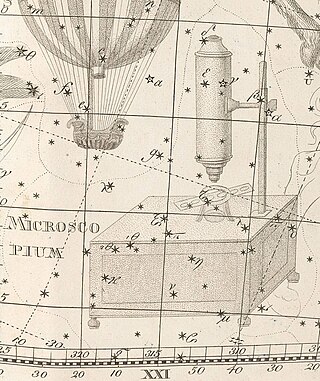Lacaille 8760
| Observation data EpochJ2000EquinoxJ2000 | |
|---|---|
| Constellation | Microscopium |
| Right ascension | 21h17m15.269s[3] |
| Declination | −38° 52′ 02.51″[3] |
| Apparent magnitude(V) | 6.67[4] |
| Characteristics | |
| Spectral type | M0Ve[5][6] |
| U−Bcolor index | +1.165[5] |
| B−Vcolor index | +1.395[5] |
| Variable type | Flare star |
| Astrometry | |
| Radial velocity(Rv) | +20.7[6]km/s |
| Proper motion(μ) | RA:−3,258.553mas/yr[3] Dec.:−1,145.396mas/yr[3] |
| Parallax(π) | 251.9124 ± 0.0352mas[7] |
| Distance | 12.947 ± 0.002ly (3.9696 ± 0.0006pc) |
| Absolute magnitude(MV) | 8.69[4] |
| Details | |
| Mass | 0.60[4]M☉ |
| Radius | 0.51[8]R☉ |
| Luminosity (bolometric) | 0.072[9]L☉ |
| Luminosity (visual, LV) | 0.029L☉ |
| Surface gravity(logg) | 4.78[8]cgs |
| Temperature | 3,800[10]K |
| Metallicity[Fe/H] | −0.01±0.04[11]dex |
| Rotation | 40±12 d[12] |
| Rotational velocity(vsini) | 3.3[6]km/s |
| Age | 4.8±2.9[13]Gyr |
| Other designations | |
| Database references | |
| SIMBAD | data |
| Exoplanet Archive | data |
| ARICNS | data |
Location of Lacaille 8760 in the constellationMicroscopium | |
Lacaille 8760(AX Microscopii) is ared dwarfstar in theconstellationMicroscopium.It is one of thenearest starsto the Sun at about 12.9light-years' distance, and the brightestM-classmain-sequencestar in Earth's night sky, although it is generally too faint to be seen without atelescope.At anapparent magnitudeof +6.7, it may only be visible to the unaided eye under exceptionally good viewing conditions, under dark skies.
This star was originally listed in a 1763 catalog that was published posthumously by theFrenchAbbéNicolas-Louis de Lacaille.He observed it in the southern sky while working from an observatory at theCape of Good Hope.[14]Number8760was assigned to this star in the 1847 edition of Lacaille's catalogue of 9,766 stars byFrancis Baily.[15]
In the past, Lacaille 8760 has been classified anywhere from spectral classK7down toM2.In 1979, theIrishastronomer Patrick Byrne discovered that it is aflare star,[16]and it was given thevariable star designationAX Microscopii, or AX Mic. As a flare star it is relatively quiescent.

Lacaille 8760 is one of the largest and brightest red dwarfs known, with about 60%[4]the mass and 51%[8]the radius of the Sun. It is about five[13]billion years old and is spinning at aprojected rotational velocityof 3.3 km/s,[6]giving it arotation periodof roughly 40 days.[12]The star is radiating 7.2%[9]of the luminosity of the Sun from itsphotosphereat aneffective temperatureof 3,800 K.[10]
Despite efforts by astronomers, as of 2011 no planets had been detected in orbit around this star.[17]
Lacaille 8760 orbits around the galaxy with a relatively highellipticityof 0.23.[18]Its closest approach to the Sun occurred about 20,000 years ago when it came within 12 light-years (3.7parsecs).[19]Due to its low mass (60% of the Sun), it has an expected lifespan of about 75 billion (7.5 × 1010) years,[20]seven times longer than the Sun's.
References
[edit]- ^e-rara.ch.Johann Elert Bode.Uranographiastar atlas (1801),Tabula XVI
- ^Johann Elert Bode.Allgemeine Beschreibung und Nachweisung der Gestirne(1801),Page 67
- ^abcBrown, A. G. A.;et al. (Gaia collaboration) (August 2018)."GaiaData Release 2: Summary of the contents and survey properties ".Astronomy & Astrophysics.616.A1.arXiv:1804.09365.Bibcode:2018A&A...616A...1G.doi:10.1051/0004-6361/201833051.Gaia DR2 record for this sourceatVizieR.
- ^abcd"The One Hundred Nearest Star Systems",RECONS,Georgia State University,retrieved2015-06-25.
- ^abcd"V* AX Mic -- Flare Star",SIMBAD,Centre de Données astronomiques de Strasbourg,retrieved2011-02-18.
- ^abcdTorres, C. A. O.; et al. (December 2006), "Search for associations containing young stars (SACY). I. Sample and searching method",Astronomy and Astrophysics,460(3): 695–708,arXiv:astro-ph/0609258,Bibcode:2006A&A...460..695T,doi:10.1051/0004-6361:20065602,S2CID16080025.See the online data.
- ^Brown, A. G. A.;et al. (Gaia collaboration) (2021)."GaiaEarly Data Release 3: Summary of the contents and survey properties ".Astronomy & Astrophysics.649:A1.arXiv:2012.01533.Bibcode:2021A&A...649A...1G.doi:10.1051/0004-6361/202039657.S2CID227254300.(Erratum:doi:10.1051/0004-6361/202039657e).Gaia EDR3 record for this sourceatVizieR.
- ^abcTakeda, Genya; et al. (February 2007),"Structure and Evolution of Nearby Stars with Planets. II. Physical Properties of ~1000 Cool Stars from the SPOCS Catalog",The Astrophysical Journal Supplement Series,168(2): 297–318,arXiv:astro-ph/0607235,Bibcode:2007ApJS..168..297T,doi:10.1086/509763,S2CID18775378,retrieved2011-08-26.
- ^abMoro-Martín, A.; et al. (March 2015). "Does the Presence of Planets Affect the Frequency and Properties of Extrasolar Kuiper Belts? Results from the Herschel Debris and Dunes Surveys".The Astrophysical Journal.801(2): 28.arXiv:1501.03813.Bibcode:2015ApJ...801..143M.doi:10.1088/0004-637X/801/2/143.S2CID55170390.Vizier catalog entry
- ^abGautier, Thomas N., III; et al. (September 2007), "Far-Infrared Properties of M Dwarfs",The Astrophysical Journal,667(1): 527–536,arXiv:0707.0464,Bibcode:2007ApJ...667..527G,doi:10.1086/520667,S2CID15732144.
{{citation}}:CS1 maint: multiple names: authors list (link) - ^Lindgren, Sara; Heiter, Ulrike (2017)."Metallicity determination of M dwarfs. Expanded parameter range in metallicity and effective temperature".Astronomy and Astrophysics.604:A97.arXiv:1705.08785.Bibcode:2017A&A...604A..97L.doi:10.1051/0004-6361/201730715.S2CID119216828.
- ^abByrne, P. B.; Doyle, J. G. (January 1989), "Activity in late-type dwarfs. III - Chromospheric and transition region line fluxes for two dM stars",Astronomy and Astrophysics,208(1–2): 159–165,Bibcode:1989A&A...208..159B.
- ^abBoehle, A.; et al. (October 2019), "Combining high-contrast imaging and radial velocities to constrain the planetary architectures of nearby stars",Astronomy & Astrophysics,630:17,arXiv:1907.04334,Bibcode:2019A&A...630A..50B,doi:10.1051/0004-6361/201935733,S2CID195874049,A50.
- ^Croswell, Ken (July 2003),"The Brightest Red Dwarf",Sky & Telescope:32,retrieved2011-02-18.
- ^Francis Baily.A Catalogue of 9766 Stars(1847),Page 219
- ^abByrne, P. B. (April 1981), "Gliese 825 - A new flare star",Monthly Notices of the Royal Astronomical Society,195(2): 143–147,Bibcode:1981MNRAS.195..143B,doi:10.1093/mnras/195.2.143.
- ^Carson, J. C.; et al. (December 2011), "Low-mass evolution - Zero-age main sequence to asymptotic giant branch",The Astrophysical Journal,743(2): 141,arXiv:1110.2191,Bibcode:2011ApJ...743..141C,doi:10.1088/0004-637X/743/2/141,S2CID119270911.
- ^Allen, C.; Herrera, M. A. (April 1998), "The Galactic Orbits of Nearby UV Ceti Stars",Revista Mexicana de Astronomía y Astrofísica,34:37–46,Bibcode:1998RMxAA..34...37A.
- ^García-Sánchez, J.; et al. (2001),"Stellar encounters with the solar system"(PDF),Astronomy and Astrophysics,379(2): 634–659,Bibcode:2001A&A...379..634G,doi:10.1051/0004-6361:20011330.
- ^Despain, K. H. (December 1981), "Low-mass evolution - Zero-age main sequence to asymptotic giant branch",Astrophysical Journal, Part 1,251:639–653,Bibcode:1981ApJ...251..639D,doi:10.1086/159510.


